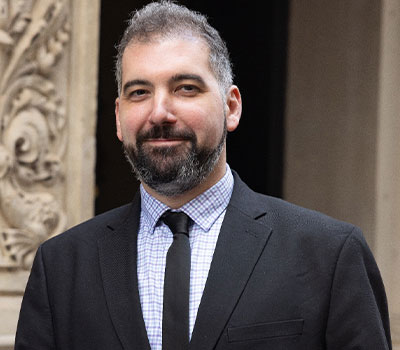This year, Randall Restiano joined Chef Michael Anthony’s team at Gramercy Tavern, adding his name to a roster that includes several legendary wine directors. The restaurant has been one of the most popular destinations in New York since it opened its doors three decades ago. “The list is a collection of so many wine buyers,” he says, having taken the baton from Erin Healy, who played a major role in shaping the cellar as the dining room regrouped post pandemic. “There was William Carroll before Erin, and then Chris Rafferty before William, and then you keep going backwards… Juliet Pope… Paul Grieco… There are things that they’ve bought that are still laying around because of the price points. There is some old vintage stuff that just hasn’t sold and it’s still here.”
Restiano’s career in restaurants began slinging pizza dough at his family’s restaurant in Bronxville until the Puglian chef kicked him out of the kitchen and sent him to the front of the house. His work has taken him to London, and into some of NYC’s top dining rooms, from Eli’s to Chef’s Table at Brooklyn Fare and Eataly. At the top of his personal roster of wine favorites is sangiovese: “I really do love 100% pure sangiovese,” he says, focusing on Tuscany, but name-checking Emilia Romagna, California, South Africa and Australia for their takes on the grape. “Sangiovese is my joy, my love that I really focus on.”
Having studied in Burgundy, Restiano also developed a fascination with pinot noir, not only from its home turf. “What’s been exciting lately has been domestic pinot noir and German pinot noir,” he finds. Here is Restiano’s view from the cellar at Gramercy Tavern, in his own words. — Joshua Greene


If I were to choose one Sangiovese, it would be the Carleone Toscana Il Guercio. The 2021. It’s a hundred percent Sangiovese made with a bit of whole cluster, and I think it encapsulates all the things that I think great sangiovese can be. A lot of people lump Sangiovese and Bordeaux and Cabernet together, but I think it’s more closely related to pinot noir. I hate saying that because every somm says the same thing.
The bottle that I sold that I was like, ‘Wow, this is really great for the price,’ was a wine from Montalcino—a magnum of Stella di Campalto Brunello di Montalcino Piccoli Contenitori. These are very expensive wines, and I feel kind of stupid saying it because it kind of is an easy [answer], but it gives me a lot of joy. It showed everything that I’ve been telling people sangiovese can taste like. It stays very true to its nature. It’s got the leather and the forest floor and the bright cherry and the acidity, but then it’s just on a whole other level. It’s very elegant. There’s depth, but there’s not power. So, it’s something that you can tell people: ‘This is the beauty of sangiovese, this is what it can be. This is why it’s one of the great wines in the world.’ And then they ask you for examples and you sometimes can’t get there. But, then, opening this bottle was—‘Yeah, here is the example. Everybody just sit back and drink this.’ It didn’t try to be something else. Some of the sangioveses that people try to show as the greats end up tasting too much like they’re trying to be Burgundy, or trying to be Bordeaux. This one stays true to sangiovese. It’s Pergola Torte from Montalcino.
•
When I came in, I focused on the areas that I thought needed to be built up on the list, which were things like Chablis. We have a lot of raw seafood and vegetables, so [Austrian] grüner. Michael Anthony is big on vegetables, and we do a lot of seafood. So a lot of the wines we serve are white wines even in the winter. So that being said, I’m a big fan of Brundlmayer, but if you wanted to know, the most sold one is a wine called Steininger, and like with the Chablis, it’s price point. Steininger sells more than all of the other ones. In Chablis, it’s really connected to people saying, ‘Oh, oh, I recognize that name. Let me buy that.’ That wine is Roland Lavantureux, which is the least inexpensive Chablis that we have—from Kermit Lynch, $115 on the list. I’m a big fan of Samuel Billaud, which I brought in as well.
And I built up Rioja because I think it works really well with a lot of the Tavern food made over the open grill. We added a lot of domestic pinot noir, and I think in the future, that’s where the focus is going to be. Our inventory of French and European wine is beautiful and very complete. I think 2024 is going to be all about domestic wine—we’re in our 30th year and we’re more and more being known as an American restaurant. I’m excited to learn even more about domestic wine—it’s the one area in 20 years of this that I haven’t spent enough time on.
For domestic pinot, there’s a wine called RAEN [an acronym for Research in Agriculture and Enology Naturally], which is from Carlo Mondavi, the son of Tim Mondavi. So we’re back in Sonoma Coast— Fort Ross Seaview 2021. I’m just in love with it. I don’t really like the polished fruit that you get in pinot from California, and it’s the opposite of that. It gives you a nice balance of savory notes, which I find sometimes very hard to find in California wine.
•
It’s been very exciting to see people gravitating towards the Savoie. It happens to fall right under Jura on the list, and so everybody’s drawn to Jura and then they see the price points have climbed since the last time they read that article that it’s cool stuff to drink. And then right below it is Savoie. And the price points are all under a hundred. And so it’s an area that’s been accessed a lot by guests without us helping them.
The most exciting thing I sold this year—a wine I thought was great—was from Galicia, and it was a red. It was Gabian Xanledo Rias Baixas Tinto, from Vigo. We do have a good selection from Galicia. We have more from Gredos—Erin was big into Sierra de Gredos, so I have a beautiful collection of garnacha from there. But I’ve been adding Galicia because I think that if I had to put my money on places that I think are going to explode, it’s Galicia, Savoie, Sicily…and that’s not only Mount Etna.
•
One of the first things I did when I joined was add a nice selection of Porto, Madeira, Sherry. It’s offered at the end of the meal, printed on the dessert menu in the tavern; in the dining room, it’s just part of the wine list that you get. And the GM said, why are we adding all of these things? And then watching them sell, we both looked at each other and said, ‘Oh, wow. I guess that worked.’ It’s been nice to see. Maybe it plays into the whole tradition of Gramercy Tavern. Like you should end your meal with a glass of Port or Madeira. Maybe that’s something that doesn’t happen in a lot of the newer-style restaurants. I’ve been having to reorder Madeira and Porto more than once in the last three months, which is shocking, because in my whole career you order it once for the year and that’s it.
Joshua Greene is the editor and publisher of Wine & Spirits magazine.
This is a W&S web exclusive. Get access to all of our feature stories by signing up today.



















